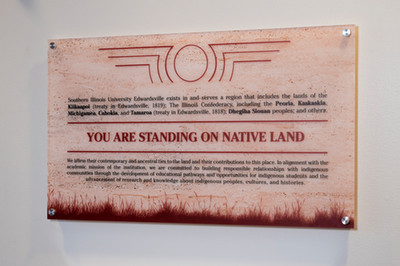SIUE Land Acknowledgement Display

Land Acknowledgement is really People Acknowledgement – to remind us that Native Americans have been here for many thousands of years, and that they are still here. To give greater visibility to SIUE’s Land Acknowledgement statement and the peoples we hope to honor, we have created a display that will showcase art pieces from Native artists; this display can be found at the north entrance of the Morris University Center.
In May of 2013, a small human figure made of clay was found at an archaeological site on the SIUE campus. This site, known as the Gehring Site (11MS99), rests between the base of the bluff and Cahokia Creek. Native Americans lived at this site as far back as 10,000 years ago, but especially significant is evidence of a Native American settlement dating to approximately 2000 years ago – what archaeologists call Middle Woodland period – and a later Native settlement dating to approximately 1000 years ago – what archaeologists call Mississippian period. The Mississippian settlement was contemporary with the great Native city of Cahokia located farther south on Cahokia Creek, and Native Americans who lived in this small village were surely Cahokian farmers.
Who were these Native peoples? The Peoria believe that their ancestors built mounds 2000-3000 years ago from the Great Lakes to the Mississippi River, and their ancestors lived here when they signed the Treaty of Edwardsville in 1818. The Kickapoo were also here at that time, signing the Treaty of Edwardsville in 1819. Living descendants of Cahokians include Osage, Quapaw, and other Indian nations. Today, the descendants of these peoples live in Oklahoma and other states, but they are alive and well and maintain their connections to this land.
The clay human figure found on the SIUE campus dates to the Middle Woodland period. Fitting easily in the palm of the hand, it is possibly a child’s toy. However, out of respect for living Native peoples who might see the figure as sacred, the display contains a contemporary clay doll made in the style of the ancient artifact rather than the artifact itself. This clay doll was made by local artist Susan Bostwick out of local clays.
Interpreting the ancient clay figure as a child’s toy, Kilan Jacobs (Osage) and his wife Mary Jacobs (Quapaw) were inspired to make a miniature toy cradleboard to accompany the clay figure in the display. Traditionally, Native cradleboards served as a safe place for a baby to rest, and toy cradle boards were made for children’s dolls. In Osage and Quapaw tradition, men are the makers of cradleboards, and women are the weavers; accordingly, Kilan made and painted the cradleboard, while Mary did the weaving that adorns it. This miniature toy cradle board has the traditional shape of the bow in front to protect the baby from being bumped. The board would have padding along its length to support the baby, and the baby would be secured to it with a sash. In some Native American groups, the cradleboard was strapped to the mother’s back, but the Osage carried the board in their arms. Cradle boards are still used today by Natives such as the Jacobs who want to maintain this connection with traditional practices.
Finally, the Land Acknowledgement Statement is presented on a sign above the artifact display in the Morris University Center. The reminder that “YOU ARE STANDING ON NATIVE LAND” is boldly centered within the statement. At the top of the sign is a sun symbol reminiscent of those commonly engraved on the shoulder of Cahokian jars. At the bottom of the sign, the profile of grasses is meant to recall the Native prairies that were so abundant here in times past.











